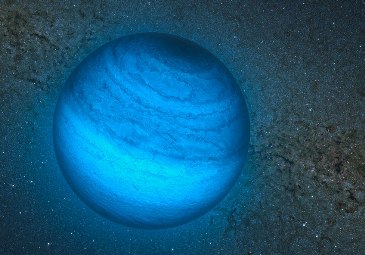Astronomers have detected a floating planet, sailing without a parent star, just 100 light-years from Earth. It’s the closest we’ve ever detected.

This floating planet is 100 light years away from Earth. It may have been ejected from its system. ESO/L. Calçada/P. Delorme/Nick Risinger (skysurvey.org)/R. Saito/VVV Consortium.
As part of a systematic survey of brown dwarfs — these aborted stars more than 13 times the mass of Jupiter — conducted with the Very Large Telescope (Chile) and the Canada-France-Hawaii Telescope (Hawaii), astronomers came across CFBDSIR2149.
The light emitted by this star did not correspond to that of a classic brown dwarf, says Philippe Delorme, of the Grenoble Observatory of Universe Sciences and the first author of the discovery. It was much colder: only 430°C versus 650°C usually, which led us to believe that it was small.”
4 to 7 times more massive than Jupiter .
To determine its mass more precisely, the team had to know its age. Indeed, as the planets cool down over time, an object appears bright either because it is young or because it is massive. Therefore, for a given luminosity, the younger an object, the less massive it is.
However, we realized that CFBDSIR2149 was very likely (95%) part of the AB Doradus star current and that it therefore displayed the same age as its component stars (all born at the same time): between 50 and 120 million years, explains the researcher. From this parameter, we deduced its mass: between 4 and 7 times that of Jupiter, much less than the least massive of brown dwarfs, we were indeed dealing with a planet.”
Methane and water vapour in its atmosphere
This is not the first time astronomers have gotten their hands on a floating planet. But all those that have been detected so far (mostly in clusters) were 3 to 5 times more distant than CFBDSIR2149, says Philippe Delorme. With this one, we got much better data, such as identifying methane and water vapour in its atmosphere.”
A planet ejected from its system?
At present, it is impossible to know how CFBDSIR2149 was formed. “Either it was born by the collapse of a lump of gas, like a star, or it formed like a planet, by accretion of small planetesimals within a system, and was then ejected from that system,” the researcher continues.
The latter scenario is quite plausible: models show that the ejection phenomenon is relatively common in the galaxy and that a planet may have paid the price in our own Solar System .
400 billion floating planets in the Milky Way
Work based on the detection of planets by microlenses has shown that floating planets are twice as numerous as stars (listen to our podcast "Exoplanets by hundreds of billions").
In our galaxy, there are 400 billion wandering planets.
After the translate i give you the link in French where the subject came from.
Une planète errante détectée non loin de la Terre

This floating planet is 100 light years away from Earth. It may have been ejected from its system. ESO/L. Calçada/P. Delorme/Nick Risinger (skysurvey.org)/R. Saito/VVV Consortium.
As part of a systematic survey of brown dwarfs — these aborted stars more than 13 times the mass of Jupiter — conducted with the Very Large Telescope (Chile) and the Canada-France-Hawaii Telescope (Hawaii), astronomers came across CFBDSIR2149.
The light emitted by this star did not correspond to that of a classic brown dwarf, says Philippe Delorme, of the Grenoble Observatory of Universe Sciences and the first author of the discovery. It was much colder: only 430°C versus 650°C usually, which led us to believe that it was small.”
4 to 7 times more massive than Jupiter .
To determine its mass more precisely, the team had to know its age. Indeed, as the planets cool down over time, an object appears bright either because it is young or because it is massive. Therefore, for a given luminosity, the younger an object, the less massive it is.
However, we realized that CFBDSIR2149 was very likely (95%) part of the AB Doradus star current and that it therefore displayed the same age as its component stars (all born at the same time): between 50 and 120 million years, explains the researcher. From this parameter, we deduced its mass: between 4 and 7 times that of Jupiter, much less than the least massive of brown dwarfs, we were indeed dealing with a planet.”
Methane and water vapour in its atmosphere
This is not the first time astronomers have gotten their hands on a floating planet. But all those that have been detected so far (mostly in clusters) were 3 to 5 times more distant than CFBDSIR2149, says Philippe Delorme. With this one, we got much better data, such as identifying methane and water vapour in its atmosphere.”
A planet ejected from its system?
At present, it is impossible to know how CFBDSIR2149 was formed. “Either it was born by the collapse of a lump of gas, like a star, or it formed like a planet, by accretion of small planetesimals within a system, and was then ejected from that system,” the researcher continues.
The latter scenario is quite plausible: models show that the ejection phenomenon is relatively common in the galaxy and that a planet may have paid the price in our own Solar System .
400 billion floating planets in the Milky Way
Work based on the detection of planets by microlenses has shown that floating planets are twice as numerous as stars (listen to our podcast "Exoplanets by hundreds of billions").
In our galaxy, there are 400 billion wandering planets.
After the translate i give you the link in French where the subject came from.
Une planète errante détectée non loin de la Terre



